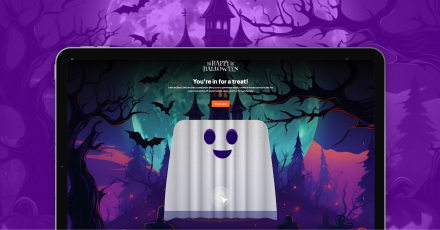Motivation, productivity, and happiness increase when employees maintain a healthy work-life balance. What does a healthy work-life balance look like? How can organizations create a culture where employees strive and thrive?
The importance of a work-life balance cannot be overstated. Creating a work environment that prioritizes individual employee well-being decreases stress, increases creativity, and reduces employee churn, which translates into a healthier bottom line.
In this guide, we explain the many benefits of a work-life balance and ways your organization can boost employee engagement and happiness through initiatives such as gamification software. Let’s get started!
What is Work-Life Balance?
As employee needs and demands change, the definition of work-life balance continues to evolve. Though the word “balance” implies equality, that’s not always the case. Sometimes the best way to define something is to talk about what it’s not. A work-life balance is not:
- Evenly doling out an equal number of hours to get things done at work and home.
- Pre-defined. Everyone’s life differs from day to day. What an employee needs today can be different from what was needed the day before and in the days to come. There are also different needs to be balanced based on whether someone is single, married, or has children. Are they new hires or close to retirement? Fluidity is key to good balance.
- One-size-fits-all. The best work-life balance is the one that works for each individual.
At the core of a healthy work-life balance are two simple yet key concepts: achievement and enjoyment. Whether it’s to increase income, buy a new home, get their kids through college—or attend after-school activities—these principles answer the “why” of people wanting a more balanced work-life relationship. We’ll talk more about cultivating achievement and enjoyment below.
The Importance of Work-Life Balance
For those who work, what they do plays a significant role in their lives. Wages ensure bills are paid, and a rainy-day fund is established. Today’s fast-paced business environment has resulted in people being more connected through technology. That’s made it more difficult than ever to separate work and home lives. In the U.S., workers often check work emails at home, take business calls during the dinner hour, and spend weekends catching up on things they didn’t accomplish during the work week.
Good organizational leaders feel a responsibility to help their employees balance their work and personal lives. They recognize that even their most engaged employees sometimes struggle to find that balance. And it isn’t only employees that benefit from a good work-life balance. Companies with a reputation for encouraging and supporting the approach are also attractive to top talent.
Benefits of Work-Life Balance
Now we circle back to achievement and enjoyment. Most people understand a sense of achievement, but enjoyment is a bit trickier. It isn’t about finding work “ha-ha” funny. It’s gained through satisfaction, pride, happiness, and overall well-being, what many people call the joys of living.
For the majority of people, achievement and enjoyment go hand-in-hand. You need only look at how many “successful” people are unhappy to understand why both are needed. Focusing on employee achievement and enjoyment creates a work-life balance that offers various benefits.
- Less burnout. Workplace burnout is sometimes unavoidable, but when people are constantly overwhelmed and unable to meet their goals, it can negatively affect every aspect of their lives. Time off, being encouraged to leave work at work, and making the workday less stress-producing can help.
- Employee engagement and retention. By helping people find the perfect balance between work and home, employee engagement and retention rates are increased, as is your bottom line. Initiatives such as work-from-home, flexible scheduling, and providing family-friendly policies are great motivators. So, too, is gamification software, which can be used to change behaviors, develop skills, and enable innovation.
- Increased productivity. Promoting a healthy work-life balance creates a work environment where everyone is dedicated to the task at hand. The result is increased productivity and, ultimately, higher profits.
- Improved mental and physical health. When people are overworked and stressed, it has a negative impact on their mental and physical well-being. Stress has been related to feelings of powerlessness and depression and disorders and diseases like high blood pressure, respiratory issues, and heart-related problems. Encouraging a balanced life significantly reduces these risks and ensures better workplace efficiency.
- Increased creativity. A healthy work-life balance improves focus and the ability to concentrate. Such mindfulness often leads to greater creativity because people spend less time worrying about work and home.
- More job satisfaction. Acknowledging the value employees bring to your organization by supporting their need for a work-life balance increases their job satisfaction. That results in them being more invested in your organization and increases their effectiveness.
Ensuring Your Workforce’s Work-Life Balance
There are as many ways to encourage a work-life balance as there are employees. Some solutions work for a majority of people.
- A flexible work environment that emphasizes taking time off allows people to easily achieve work-related and personal tasks without stressing about how to fit everything into their schedule. It’s also good for business!
- Implement short breaks throughout the day so people can relax and recharge. This is another way gamification can contribute to a healthier work environment, giving people the enjoyment they need.
If you’re struggling to come up with innovative ways to promote a healthy work-life balance, ask your employees for suggestions and guidance! Who knows better what changes would improve their situation? Regularly scheduled meetings and real-time feedback programs can provide you with all the inspiration you need.
Finally, don’t forget to practice what you preach. Don’t encourage balancing work and home and then keep long hours at the office yourself. Refrain from sending work-related emails out during off-hours. Several European countries have “right to disconnect” laws in place, and it’s easy to adapt those ideas to your workplace. Some U.S. cities are already exploring enacting similar laws.
Strike a Balance
Most people spend a large percentage of their time at work. If they’re not careful, it can also take over their personal lives. Keeping this in mind and adopting steps to keep the two separate helps keep lives balanced. Loosening the reins on what’s expected from employees helps build an engaged and productive workforce. By creating a work environment that emphasizes and encourages a work-life balance, you’ll find people enjoy their work more and are more enthusiastic about helping your organization achieve its goals.
About BeeLiked
BeeLiked offers customizable gamification solutions that can improve productivity and retention. A happy workforce results in a more productive workforce, and demonstrating the importance of company culture and work-life balance is a fundamental step.
















